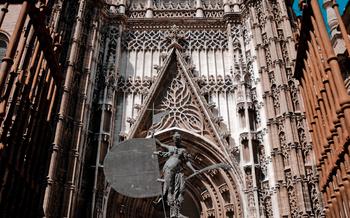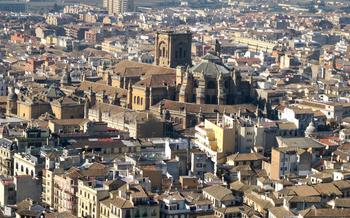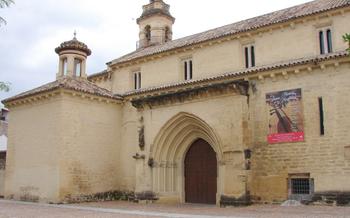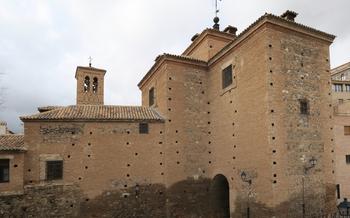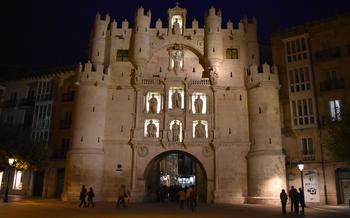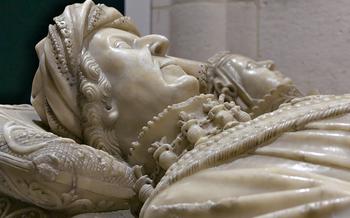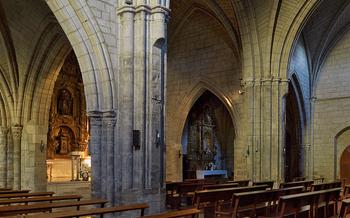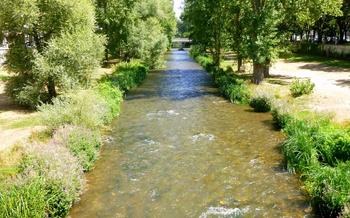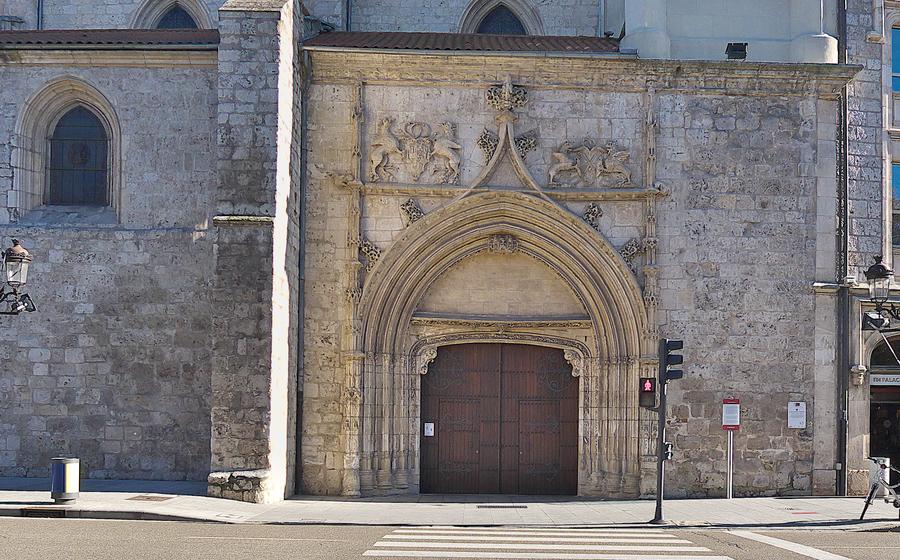
Iglesia de la Merced
- Iglesia de la Merced: A Monumental Treasure in Burgos
- Location and Access Information:
- Visiting Hours and Admission Fees:
- Guided Tours and Accessibility Options:
- Unraveling the Architectural Masterpiece
- A Journey Through the Church's Interior
- The Altarpiece: A Symphony of Sacred Art
- Unveiling the Stained Glass Windows: Luminous Masterpieces
- Exploring the Intricate Carvings and Sculptures
- The Cloister: A Serene Retreat Within the Church
- The Church's Role in the Community: A Center of Faith
- Local Legends and Folklore Surrounding the Church
- Educational Programs and Workshops at the Church
- Accessibility and Facilities for Visitors: Ensuring Inclusivity
- Insider Tip: Unforgettable Views from the Bell Tower
Iglesia de la Merced: A Monumental Treasure in Burgos
Nestled in the heart of the historic city of Burgos, Spain, stands the magnificent Iglesia de la Merced, a testament to the region's rich cultural and religious heritage. This architectural masterpiece, dating back to the 13th century, is a stunning example of Gothic and Renaissance styles, and its intricate details and historical significance make it a must-visit attraction for travelers seeking an immersive experience.
Location and Access Information:
The Iglesia de la Merced is conveniently situated in the city center, just a short walk from the iconic Burgos Cathedral. Visitors can easily reach the church on foot, by bicycle, or by public transportation.
Visiting Hours and Admission Fees:
The church is open to the public from Monday to Sunday, with varying hours depending on the season. General admission tickets are available at the entrance, offering visitors the opportunity to explore the church's interior and admire its stunning features.
Guided Tours and Accessibility Options:
For a more in-depth exploration, guided tours are available in multiple languages, providing visitors with insights into the church's history, architecture, and religious significance. The church is also equipped with accessibility features for visitors with disabilities, including ramps, elevators, and accessible restrooms, ensuring an inclusive experience for all.
Unraveling the Architectural Masterpiece
The Iglesia de la Merced's architectural design showcases a harmonious blend of Gothic and Renaissance elements, reflecting the transition between these two significant periods in art and architecture. The exterior facade captivates with its intricate carvings, pointed arches, and elaborate ornamentation, embodying the essence of the Gothic style. The interior, on the other hand, reveals a more subdued elegance, with clean lines, classical proportions, and intricate rib vaults characteristic of the Renaissance.
The church's layout follows a traditional cruciform plan, featuring a central nave flanked by two aisles. The nave is separated from the aisles by rows of slender columns, which support the soaring ribbed vaults that define the ceiling. These vaults, with their intricate patterns and decorative bosses, create a sense of height and grandeur within the sacred space.
Gothic and Renaissance influences can be discerned in various architectural details throughout the church. The pointed arches and ribbed vaults, typical of Gothic architecture, lend a sense of verticality and lightness to the interior. In contrast, the Renaissance influence is evident in the classical proportions and symmetry of the interior spaces, as well as in the intricate carvings and decorative elements that adorn the walls and altars.
Overall, the Iglesia de la Merced stands as a testament to the architectural prowess of its builders, seamlessly blending Gothic and Renaissance elements to create a harmonious and awe-inspiring space that inspires both spiritual contemplation and artistic admiration.
A Journey Through the Church's Interior
At the heart of the Iglesia de la Merced, visitors embark on a journey through a sacred space adorned with exquisite works of art. The main altarpiece, a masterpiece of Gothic craftsmanship, captivates the eye with its intricate details and vibrant colors. Its central figure, the Virgin Mary, exudes an aura of serenity and compassion, surrounded by intricate carvings depicting scenes from her life.
The church's stained glass windows, a symphony of light and color, narrate biblical stories with vivid imagery. Bathed in natural light, they cast a warm glow upon the interior, transforming the atmosphere into a sanctuary of spirituality and awe.
Intricate carvings and sculptures adorn the walls of the church, each one a testament to the skill and devotion of the artisans who created them. Angels, saints, and biblical figures come to life in these intricate works of art, adding depth and dimension to the sacred space.
Chapels and side altars, tucked away from the main nave, offer hidden gems to be discovered. Dedicated to various saints and adorned with unique features, these smaller spaces provide a sense of intimacy and contemplation, inviting visitors to connect with the divine in a personal and profound way.
The Altarpiece: A Symphony of Sacred Art
At the heart of the Iglesia de la Merced, the altarpiece stands as a testament to the church's artistic prowess. Created in the 16th century, this masterpiece is a symphony of sacred art, captivating the eyes with its intricate details and profound symbolism.
The Masterpiece's Central Figure and Its Symbolism
The centerpiece of the altarpiece is a stunning depiction of the Virgin Mary, holding the infant Jesus in her arms. The Virgin's serene expression and gentle gaze exude an aura of divinity, inviting viewers to contemplate her role as the mother of God. The placement of the figures within a mandorla, a luminous almond-shaped frame, further emphasizes their celestial significance.
The Flanking Panels and Their Depictions of Biblical Scenes
Flanking the central figure are a series of intricately carved panels, each narrating a different biblical scene. These panels depict various moments from the life of Christ, from his nativity to his crucifixion and resurrection. The vivid portrayal of these scenes, with their lifelike figures and dramatic compositions, immerses viewers in the sacred stories they represent.
The Altarpiece's Historical Significance and Artistic Value
The altarpiece of the Iglesia de la Merced holds immense historical and artistic value. It is considered one of the finest examples of Renaissance art in Burgos, showcasing the exceptional craftsmanship and artistic vision of the period. The altarpiece has undergone meticulous restoration efforts over the years, ensuring its preservation for future generations to appreciate.
The Restoration Process and Conservation Efforts
The restoration of the altarpiece was a painstaking process that required the expertise of skilled conservators. They meticulously cleaned and repaired the delicate carvings, addressing centuries of wear and tear. The restoration process aimed to preserve the altarpiece's original beauty while ensuring its structural integrity for years to come.
Unveiling the Stained Glass Windows: Luminous Masterpieces
The Iglesia de la Merced boasts a collection of exquisite stained glass windows that illuminate the interior with vibrant hues and sacred narratives. These luminous masterpieces, crafted by skilled artisans, depict biblical stories and symbols, adding depth and spiritual significance to the church's atmosphere. The windows serve as portals to the divine, capturing the essence of faith and devotion through their intricate designs.
Natural light streams through the stained glass, casting a warm glow upon the church's interior. The interplay of light and color creates a mesmerizing effect, transforming the space into a celestial sanctuary. Each window tells a story, inviting viewers to contemplate the teachings and parables of the Bible. The stained glass windows are not merely decorative elements; they are integral to the church's spiritual ambiance, enhancing the sense of awe and reverence within the sacred space.
Extensive restoration efforts have been undertaken to preserve these fragile works of art. Skilled artisans have meticulously restored the windows to their original splendor, ensuring that future generations can continue to marvel at their beauty and spiritual significance. The painstaking process of restoration involved careful cleaning, repair, and replacement of damaged glass pieces, ensuring the integrity and longevity of these priceless treasures.
Exploring the Intricate Carvings and Sculptures
Intricate carvings and sculptures adorn the walls and various elements of the Iglesia de la Merced, adding depth and symbolism to the church's interior. These artworks, meticulously crafted by skilled artisans, hold significant religious and cultural value.
The carvings and sculptures depict a range of biblical scenes, saints, and allegorical figures, each with its own unique story to tell. The attention to detail and the expressive nature of the artwork bring these figures to life, inviting visitors to contemplate their deeper meanings.
The choir stalls, in particular, showcase exceptional craftsmanship, with intricate carvings adorning the seats and canopies. These carvings depict various biblical scenes, including the Annunciation, the Nativity, and the Last Supper, offering a visual narrative of key moments in Christian history.
The impact of these carvings and sculptures on the overall aesthetic of the church is profound. They create a sense of awe and wonder, drawing the viewer's attention to the spiritual significance of the space. The interplay of light and shadow on the three-dimensional forms enhances the drama and emotion conveyed by these artworks.
Exploring the intricate carvings and sculptures of the Iglesia de la Merced is a journey into the heart of the church's artistic and spiritual heritage. These masterpieces, created with devotion and skill, continue to inspire and captivate visitors, leaving a lasting impression of the church's rich history and enduring beauty.
The Cloister: A Serene Retreat Within the Church
Beyond the bustling nave and the awe-inspiring chapels, the Iglesia de la Merced holds a hidden gem – its cloister, a tranquil oasis of serenity and contemplation. Step through an unassuming doorway, and you will be transported into a world of architectural harmony and spiritual reflection.
The cloister, constructed in the Gothic style, features a series of graceful arches supported by slender columns, creating a rhythmic pattern that invites contemplation. The intricate stonework is a testament to the skill and artistry of the medieval craftsmen who brought this sacred space to life.
The cloister's central courtyard, adorned with manicured gardens and a soothing fountain, provides a sanctuary for quiet reflection and prayer. The gentle sound of water trickling and the fragrant aroma of blooming flowers create an atmosphere of tranquility, inviting visitors to slow down, breathe deeply, and connect with their inner selves.
Originally, the cloister served as a place of retreat and contemplation for the Mercedarian friars who resided in the monastery. They would gather here to pray, read, meditate, and seek solace from the outside world. The cloister's serene ambiance facilitated their spiritual growth and connection with the divine.
Today, the cloister remains a place of tranquility and spiritual reflection, open to visitors who seek a moment of peace and respite amidst the bustling city. Whether you are a history buff, an architecture enthusiast, or simply someone seeking solace, the cloister of the Iglesia de la Merced offers a unique and enriching experience.
The Church's Role in the Community: A Center of Faith
The Iglesia de la Merced holds a profound significance in the religious and cultural fabric of Burgos. It stands as a cherished place of worship and pilgrimage for the local community and visitors alike. Throughout the centuries, the church has played a pivotal role in hosting significant religious ceremonies and celebrations, fostering a deep sense of faith and devotion among the faithful. The church's spiritual influence extends beyond its walls, impacting the lives of countless individuals and shaping the collective religious identity of Burgos. Its enduring presence serves as a testament to the enduring power of faith and its ability to unite people in shared beliefs and traditions.
Local Legends and Folklore Surrounding the Church
The Iglesia de la Merced has inspired a rich tapestry of local legends and folklore, adding to its mystical charm. One captivating tale speaks of a hidden treasure buried beneath the church's foundations. Legend has it that during the construction of the church, a group of monks discovered a chest filled with gold coins and precious jewels. Fearing that the riches would be stolen or misused, they decided to conceal the treasure within the church walls, ensuring its safety and secrecy.
Another enchanting legend tells the story of a mysterious monk who appeared to a young woman in distress. Desperate for guidance and solace, the woman sought refuge in the church, where she encountered the monk. He listened attentively to her troubles and offered words of wisdom and comfort. Before disappearing, the monk left behind a single rose, which the woman cherished as a symbol of hope and divine intervention.
These legends and stories have been passed down through generations, becoming an integral part of the church's history and cultural significance. They serve as a testament to the power of imagination and the enduring connection between the church and the local community.
Educational Programs and Workshops at the Church
The Iglesia de la Merced extends its commitment to the community by offering a variety of educational programs and workshops. These initiatives aim to engage visitors of all ages and backgrounds in learning about the church's rich history, art, and architecture.
Families with children can participate in interactive workshops that introduce them to the church's stories and symbols in a fun and engaging way. Through hands-on activities, storytelling, and exploration, children develop a deeper appreciation for the church's cultural and spiritual significance.
Adults, too, can delve into the church's history and artistic treasures through lectures, guided tours, and workshops. Experts in art history, architecture, and religious studies lead these sessions, providing insights into the church's construction, design, and the symbolism behind its artworks.
The educational programs and workshops at the Iglesia de la Merced serve as a platform for preserving and sharing the church's legacy. By actively engaging the community in learning experiences, the church ensures that its stories and traditions continue to inspire and educate future generations.
Accessibility and Facilities for Visitors: Ensuring Inclusivity
The Iglesia de la Merced is committed to providing an inclusive and welcoming environment for all visitors. Accessibility features have been implemented to ensure that individuals with disabilities can fully experience the church's grandeur. Wheelchair ramps and elevators provide easy access to different levels of the church, allowing visitors to navigate the building without barriers. Additionally, guided tours and information are available in multiple languages, catering to the diverse needs of international visitors. Restrooms, seating areas, and parking facilities are well-maintained and conveniently located for the comfort and convenience of all guests. These efforts underscore the church's dedication to creating an inclusive space where everyone can appreciate its historical and cultural significance.
Insider Tip: Unforgettable Views from the Bell Tower
For a breathtaking perspective of Burgos, venture to the bell tower of the Iglesia de la Merced. This historic tower stands as a testament to the city's architectural heritage, offering panoramic vistas that will leave you spellbound. As you ascend the winding staircase, the anticipation builds, and upon reaching the top, you'll be rewarded with an unforgettable sight.
The city of Burgos unfolds before you, a tapestry of medieval charm and modern elegance. Gaze upon the iconic spires of the Burgos Cathedral, rising majestically against the backdrop of the surrounding hills. Trace the meandering streets, lined with historic buildings that whisper tales of the city's rich past.
To fully appreciate the beauty of Burgos, time your visit to coincide with the golden hour. As the sun dips towards the horizon, the city is bathed in a warm, ethereal glow, casting long shadows that accentuate its architectural wonders. The sky transforms into a canvas of vibrant hues, creating a magical atmosphere that lingers in the memory.
For those with a head for heights and a thirst for adventure, the bell tower of the Iglesia de la Merced offers an unforgettable experience. Whether you're a seasoned traveler or a first-time visitor, the panoramic views from the top will undoubtedly leave a lasting impression.

